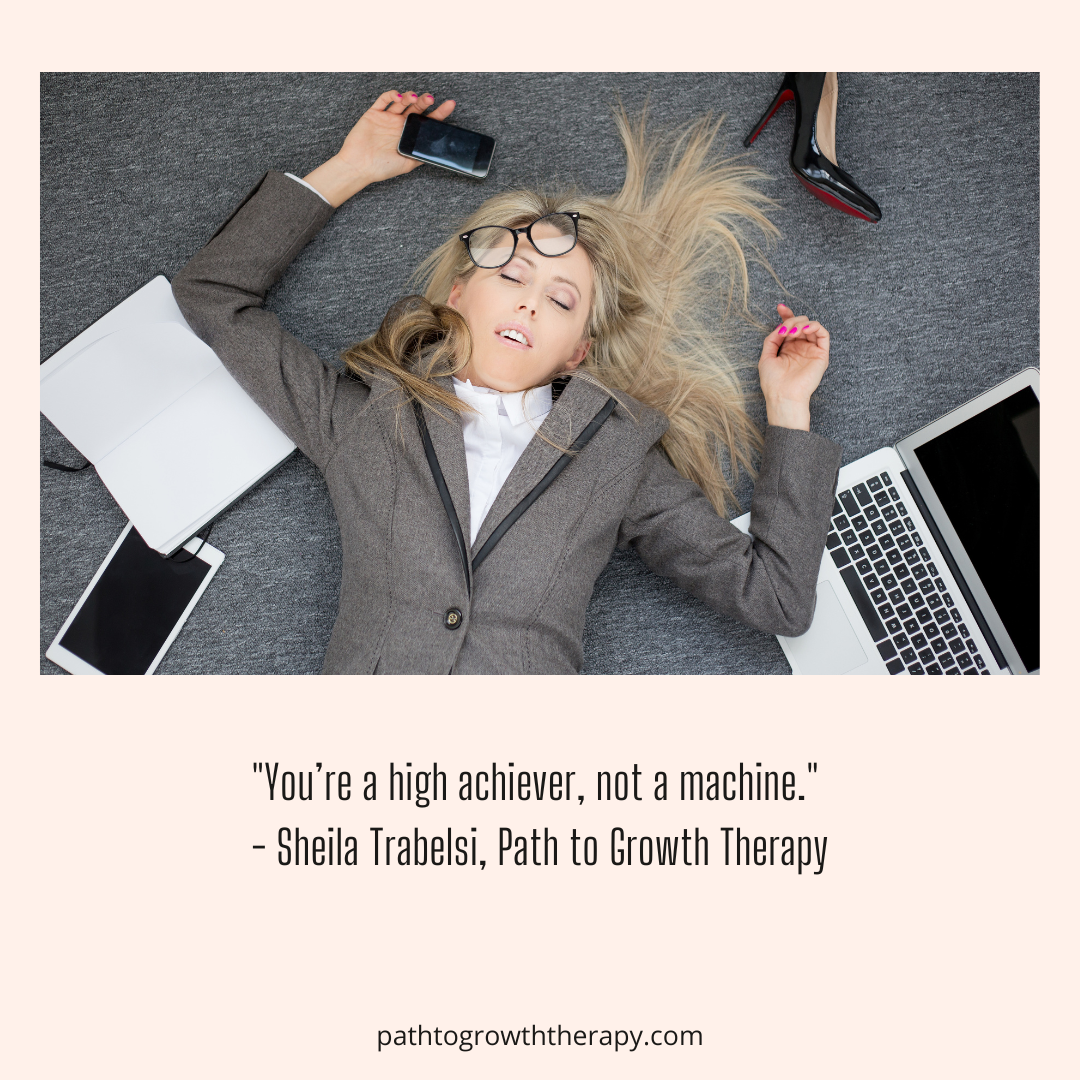Are You a High Achiever or Just Running on Overdrive? The Hidden Cost of Working Like a Machine
Work With Me
a licensed professional counselor with 15 years of experience in the field. I earned my B.S. in Psychology and Master’s in Counseling from Colorado State University and am the proud owner of Path to Growth Therapy and Trabelsi Coaching & Consulting.
I provide therapy for individuals and couples across Colorado and Washington, and mindset coaching and consulting services to clients worldwide. My specialties include grief, trauma, anxiety, life transitions, and relationship challenges. With a strengths-based, trauma-informed, and action-oriented approach, I help clients move beyond challenges and step into lasting healing and growth.
Meet Sheila
May 13, 2025
In our hustle-heavy culture, it’s easy to confuse working hard with overworking. Especially for professionals in high-stress careers—executives, therapists, healthcare workers, lawyers, founders, and leaders—the line between “high achiever” and “burned-out machine” often gets blurred.
As someone who works with high-performing individuals, I often see clients who pride themselves on their productivity, perfectionism, and their capacity to push through stress. But behind the scenes, many are struggling to breathe—let alone rest. They often can’t say no, fear being perceived as lazy, and feel stuck in a cycle of guilt and anxiety when they do try to slow down.
Here’s a simple mantra to keep in mind:
“You are a high achiever, not a machine.”
Let’s unpack what this actually means—and how to tell the difference between the two.
High Achiever vs. Machine: What’s the Difference?
| Trait/Behavior | High Achiever | Machine Mode |
|---|---|---|
| Motivation | Purpose-driven, growth-oriented | Fear-driven, perfectionistic |
| Boundaries | Protects time and energy | Overcommits and overfunctions |
| Self-Talk | Encouraging, values rest | Critical, glorifies overwork |
| Response to Stress | Uses tools to regulate | Ignores stress until burnout |
| Productivity | Strategic and sustainable | Reactive and relentless |
You might shift between these states without even realizing it. But the more time you spend in “machine mode,” the more you’re at risk for:
- Chronic anxiety
- Sleep issues
- Fatigue and brain fog
- Digestive issues and inflammation
- Burnout and decreased creativity
The Cost of Constant Hustle
Many high performers tell me they’re just “wired this way.” But the truth is, working nonstop isn’t sustainable—and it’s not what research supports.
Studies consistently show that breaks and downtime increase productivity. The brain needs time to process, consolidate memory, and spark creativity. Without space to rest, you’re just running a program on loop—no upgrades, no innovation, no repair.
Pushing through constant stress doesn’t make you a stronger leader. It makes you more vulnerable to burnout and less available to your team, clients, or loved ones.
Why It’s So Hard to Say No
Clients often say things like:
- “I don’t want to let my team down.”
- “My boss expects me to be available.”
- “If I stop, everything falls apart.”
- “People respect my work ethic.”
Underneath these beliefs is often a deeper fear: If I stop producing, I lose my value.
But here’s the truth: You are more than what you do. Your worth isn’t tied to your output. And people pleasing, over-functioning, and perfectionism are often trauma responses—not traits of true leadership.
Use Your Anxiety Before It Uses You
Here’s a reframe: A little anxiety can be useful—if you catch it early.
If you feel the twinge of tension, the creeping resentment, the edge of overwhelm—that’s your system asking for a reset. If you ignore it, it builds. Then it becomes panic, shame, and complete shutdown.
But when you tend to the small signs, you stay ahead of the wave.
Quick Wins: Micro-Interventions That Work
You don’t need an hour-long meditation or a weekend retreat to feel better. Start small. These one-minute tools can make a noticeable difference:
- 60-Second Body Scan: Close your eyes and scan from head to toe. Notice tension. Soften your jaw. Relax your shoulders.
- Box Breathing: Inhale for 4, hold for 4, exhale for 4, hold for 4. Repeat 3 times.
- Micro-Check-In: Ask yourself: What am I feeling right now? What do I need? One word answers are enough.
- Tension Release: Stand up, shake out your arms, or do five wall pushups.
- Name a Win: Write down one thing you did well today. Let yourself feel it.
These micro-moments reset your nervous system. They create the space for sustainable achievement.
Reclaiming Balance Doesn’t Make You Lazy
You don’t need to stop being ambitious. But you do need to stop abandoning yourself in the process.
Set one boundary this week. Cancel one non-essential task. Say no once without over-explaining. That’s how you reclaim your energy.
And if you need help learning how to do this—this is the work I do. I help high performers stay high-performing—without losing themselves.
Let’s stop equating success with self-sacrifice.
Ready to shift from surviving to thriving? If you’re done living on autopilot and want real tools to quiet the noise, reset your nervous system, and build a life that’s full—not just busy—let’s work together. Your high-achieving life should include joy, connection, and time to breathe.
